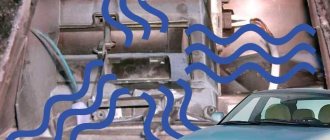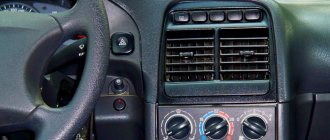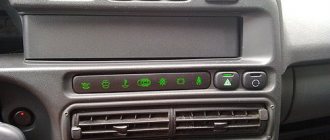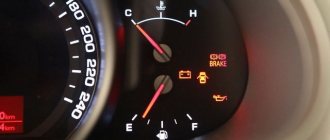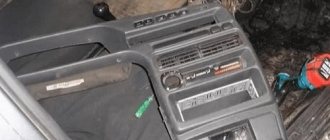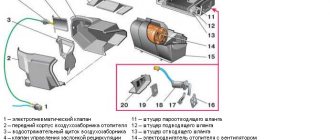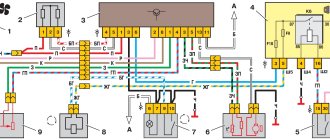Causes of cold air from the stove
There are quite a few reasons why the heater can blow cold air, and to determine the specific cause, you will have to tinker a little with the car in order to correctly diagnose the breakdown.
List of reasons:
- The heater radiator is clogged;
- The damper position gearmotor is broken;
- Thermostat is faulty;
- Insufficient amount of coolant;
- The expansion tank cap is faulty;
Let's look at each of the reasons in more detail and start with the most primitive ones.
We carry out comprehensive diagnostics
Removing a faulty heater from a Lada Priora is not so easy. Even experienced motorists cannot cope with this task quickly. To avoid doing such a large amount of work in vain, it is better to first diagnose the heating system. You must proceed as follows:
- We probe the channels through which the coolant flows to the heater. They should be warm when the stove is on. In addition, when pressing on the main rubber hoses, resistance should be felt. If resistance is not felt, the pump pump may be faulty. This mechanism is responsible for creating the pressure of fluid flows necessary for normal operation of the heater.
- A little secret that may be useful to Lada Priora owners: does the stove blow cold air for a long time and does not warm up as quickly as we would like? Then you can try filling coolant to the bottom mark in the tank. In this case, the liquid will warm up faster. If you practice this method, you will need to constantly check the coolant level.
- If a running heater is a source of noise, then we can talk about a problem in the bearing, which is located on the electric fan. This situation cannot be ignored, since in the future the fan may jam and repairs will take place on a much larger scale.
- Is the stove not working? Perhaps the problem is hidden in fuse F9 with a rating of 25 A. Its function is to protect the power electrical lines of the heater. A blown fuse must be replaced. If such a situation occurs with enviable consistency, then it is necessary to check all electrical circuits of the heater, the insulation of the windings on the fan and the presence of an overload in the power circuit.
Failure of the expansion tank cap
The expansion cap is a plug that prevents splashing of coolant in the engine compartment, but this is not its only task. The lid has a built-in valve in its design that relieves excess pressure and allows the required amount of air into the system so that vacuum and vacuum are not created in it. If the cap valve is faulty, then in cold weather a vacuum may be created in the cooling system, which will prevent good circulation through the heater radiator, and this will lead to insufficient heating of the radiator.
When unscrewing the plug, it is necessary to check its external condition; there should be no rust or traces of oxide on it. If the valve becomes stuck, the cover must be replaced.
Heater radiator malfunctions
Another reason why the deflectors in a Lada Priora car do not work may be the accumulation of dirt in the heat exchanger. When the cooling system operates, deposits accumulate in the engine block itself over time, which are then spread throughout the entire system, including into the heater radiator. These deposits prevent it from working effectively. The system will heat the air worse. In this case, the heater radiator can be replaced entirely. It is removed from the engine side. Before starting work, be sure to drain the antifreeze from the cooling system. Then dismantle the windshield wiper arms, the frill trim and move aside part of the soundproofing shield. After this, disassemble the stove body, disconnect the wires, remove the fan motor along with the impeller and remove the heat exchanger, disconnecting the supply hoses from it.
Thermostat is faulty
If the thermostat malfunctions, the car will take quite a long time to warm up in the cold season. This is due to the fact that the coolant will circulate in a large circle through the cooling radiator and it will be much more difficult for the engine to warm up to operating temperature. As you know, the lower the temperature of the engine and coolant, the colder it blows from the stove.
You can check the thermostat by starting the car and letting it run for 10 minutes, and then touch the lower radiator hose, it should be cold until the car warms up to operating temperature. If the lower radiator hose warms up evenly with the upper one, this means that the thermostat is stuck in the open position and needs to be replaced.
Recommendations
Comments 42
He’ll overlook the antifreeze) so the first reason is the green thing... If necessary, I’ll write about it a little later
Thanks, I'll wait
And so, if the gearmotor is in working condition and does not jam, then the problem is with the Additional heater resistor. It is when this thing fails that hot air stops flowing into the cabin. On my Priora, the gear motor broke at one time, the characteristic sound of its operation was not heard... after replacement, everything was normal. The guy on the luxury Prior also had a problem with hot air, but he got around it by adding antifreeze, the pipe was leaking. Another friend had this problem, and it was his resistor that burned out. So first test the gear motor, if that’s not the problem, then change the resistor. They are located close to each other. Here is a link to the structure of the Priora stove, which was the first one I came across. Number 6 is that ill-fated green thing in the color picture)))) club-lada.rf/priora-remont/220-pechka-priora.html
Thanks a lot! I decided not to climb myself, I’ll go to the station.
The first reason is to check the antifreeze level. Next comes the damper gear motor, if when you turn the knob that switches hot cold air you can’t hear it working, then it’s it. If it switches, then the problem is (I don’t remember exactly what this green thing under the hood in the stove body is called), but it is this thing that is responsible for the hot air.
look at the pump, it's probably leaking brains
Perhaps it was the pump I had like this, the impeller fell off and turned, it was also blowing cold, I dismantled the stove, changed the gear motor, radiator, and then as it got warmer the car began to warm up, I changed the pump and that’s it Tashkent
I'm not inclined towards the pump. I’ve been driving like this for a year now, I think it would prove itself in the summer...
Class! Thank you! Maybe I'll change it today!))))
Option 1 - the problem is in the gear motor gear, it does not turn until it warms up. Option 2 - the problem is in the temperature sensor in the ceiling, it is this that regulates the position of the heater damper, depending on the temperature in the cabin and the desired temperature on the regulator. If you turn off this sensor, then the position of the damper will correspond to the position on the regulator.
It doesn't need to warm up to turn over. It is already lubricated with lubricant in a sealed housing. There’s nothing special for her to warm up there. It won't turn if its teeth break. Desynchronization of the position of the damper and the control knob occurs precisely because the sensor sends a signal to an already obviously broken regulator. A gear with broken teeth jumps over normal ones. Over time, the next teeth will break, and as a result an unpredictable wedge
Are you treating from photographs?
necessary, not necessary - the fact is the fact that the damper turns only when the engine is warmed up. What prevents the gear motor from rotating until it warms up? and it rotates... not immediately, but much later - which means warming up is important. and if it had been teeth, it would have turned right away. without waiting for it to warm up. A gear with broken teeth jumps over normal ones - complete nonsense. disassemble the gear motor at least once. the teeth there do not break, but the edges are eaten away and that is why a wedge appears.
There is no desynchronization between the handle and the sensor; it contains the principle of a constantly adjusting heater damper, based on the readings of the interior temperature sensor. Let’s say we want 20+ and we have 12, then the gear motor will open the damper as much as possible, then as the interior warms up, as it warms up it lowers it to a position in which the flow of hot air will maintain 20+ in the cabin.
not from the photo, but from experience, I myself changed 3 of these gearboxes; all of them had 3 broken teeth on the selector gear, I took them apart and saw how they were arranged inside, the teeth were broken, not ground off. The gearbox does not need heating to operate. The gearbox starts moving as soon as you start the car - IMMEDIATELY look for a new position from the one in which it remained before turning off, taking into account the changed weather realities, as shown by the sensor in the cabin. It moves immediately, without warming up. And if you left it at 20+ and it’s -10 outside in the morning, then in order to heat the solon again to 20+, the damper will start from a different position, immediately setting it to 20+ and not the maximum, this is not required of it. And it will begin to move slowly after the interior has warmed up to 20+, reducing the warm air, thereby maintaining 20+. And it is during the initial start-up that the teeth in the gearbox break - for what reason - that’s another matter, wear there or a high starting current or something else. When 1 tooth is broken, it’s not scary, but when 2 or more are broken, it begins to jump or slip, causing a mismatch between the position of the damper and the control knob, and when, for example, you want heat, the lack of teeth does not allow you to move the damper to this position. So disassemble the gearbox yourself, just break 2-3 teeth, rotate the broken gear against the whole one and see how a discrepancy arises. As a result, the broken gear will take such a position that neither the manual control nor the sensor will move it.
Heater radiator clogged
When the heater radiator is clogged, the circulation of coolant through it becomes much worse, which leads to insufficient heat exchange. A clogged radiator occurs as a result of neglecting to replace the coolant for a long time.
Checking for a clogged radiator can be done by touching the pipes supplying coolant to it; they should both be hot, but if one of them is hot and the other is cold, then most likely the radiator is clogged. The check should be carried out with the heater fan turned off.
This condition is met if the air flow from the air ducts is of sufficient strength, but cold. If the flow is weak but hot, then most likely it is necessary to replace the cabin filter.
Engine cooling system problems?
As practice shows, most problems with the Priora stove occur due to the ESD (engine cooling system). In this case, the procedure is as follows:
1. Check the coolant (coolant) level in the expansion tank so that it is between o and “MAX”. If coolant needs to be added constantly, the cooling system is leaking somewhere. It is necessary to carefully inspect all pipes for leaks and tighten the clamps. By the way, in order for warm air to get into the cabin faster, many car enthusiasts in winter specifically add coolant only to about 0. After all, the less liquid in the system, the faster it heats up.
2. Check the coolant circulation in the coolant, paying attention to the expansion tank. Example:
3. Checking the thermostat. We warm up the engine to 75 degrees and hear the upper radiator hose (in diagram 13), if it is cold, the coolant circulates only in a small circle, the thermostat should be replaced with a new one.
If the furnace is blowing cold air, the cause may be SOD aeration. Read how to remove air from the engine cooling system.
More detailed information can be found in the article “Diagnostics and repair of Priora SOD”.
Damper position motor
This breakdown occurs quite often on Priora. The heater damper position motor reducer is a DC motor that rotates to move the damper, which opens the air flow through the radiator. Often after the summer season, when the damper remains in the open position for a long time, the motor rusts and can no longer rotate, and therefore cannot move the damper.
Heating system elements (stoves)
The fact that the Priora stove is 95% similar to the “ten” can be seen by the catalog numbers:
- Heater assembly (2170-8101012 or 2111-8101012-10).
- Air flow distribution gearmotor (2170-8127100). Distributes air flow to the feet/face/windshield. Located inside the dashboard.
- Interior air temperature sensor (11186-8128050). Located on the ceiling.
- Heater control controller (HCU) or stove control unit (21703-8128020). The block on which the driver sets the operating parameters of the stove. Located on the panel.
- Additional resistor or additional resistor (2123-8118022). Determines the rotation speed of the stove fan. Secured in the engine compartment.
- Electric heater fan (2111-8118020). Located under the hood.
- Heater damper motor reducer (2110-8127200). Distributes air flows into the cabin (outside/heater radiator). Inside the heater assembly.
- Air filter (2110-8122020).
- Heater radiator (2110-8101060). Located inside the heater.
A malfunction of one of these elements causes problems in the operation of the stove.
Only speeds 1 and 4 work
Often such a malfunction occurs when the stove switch gives a command only in the extreme positions. The cause of breakdown is often additional resistance, which reduces the rotation speed of the furnace device.
The resistor is a block where the fourth speed is direct and without retardation. The device is located in the heater housing on the left and is secured with a pair of screws.
In a situation where the first three positions do not work, and only the 4th one functions, the cause may be a broken resistor (mentioned above) or a failure of the heating and ventilation system control unit. The last malfunction is more common.
The elements responsible for the operation of the Lada Priora stove are shown below.
No heating at idle
It is not for nothing that this issue has been submitted for separate consideration, since it worries many motorists and solving the problem can be much more difficult than one might expect. So, you have a Priora, the heater does not heat up at idle, although when the car is moving, the interior is heated in normal mode. Here you can also identify several possible reasons:
- Insufficient coolant level.
- Leaks that lead to a decrease in antifreeze levels.
- There is an air lock in the system.
If the first two problems can be easily diagnosed and eliminated, then with an air lock the situation is much more complicated. If you have ruled out the first two reasons and the Priora’s stove still does not heat up at idle, you need to eliminate the air lock. You must proceed as follows:
- We remove the screen from the engine.
- We lower the clamp, after which it is necessary to remove the heating tube for the throttle assembly. We choose any of the two.
- Unscrew the cap on the expansion tank. We place a clean rag on the neck and begin to blow into the expansion tank. The air supply should be carried out until coolant begins to pour out of the tube, which was previously removed.
- Immediately place the tube on the fitting and carefully tighten the clamp.
- Installing the screen.
Preparatory stage
Troubleshooting the heater should begin provided that the power unit and engine cooling system are in order to eliminate their influence. To do this, you need to make sure that the antifreeze is poured in the proper amount, the engine is in good condition and is functioning normally. And after that, find out why the stove on the Priora does not work. First, check the coolant level in the expansion tank. Next, you need to start the engine and warm it up to operating temperature. After this, you need to check the serviceability of the thermostat - feel the thick hoses that go from it to the car radiator.
The top one should gradually become hot. If the rubber hose is still cold, the thermostat is faulty. In this case, you can continue working only after replacing this element. Fortunately, its cost is low.
Another reason why the engine may not warm up to operating temperature is a leaky expansion tank cap. It should keep excess pressure in the system. Often, simply replacing this cover can completely eliminate the problem.
On the Priora, unlike the Tens, the cooling system is organized differently. And the formation of an air lock there is practically excluded. It can occur when the system is leaking or when antifreeze is poured into a completely empty expansion tank. This can be fixed quite simply. You need to drive your front wheels up some hill in a warm car and vigorously apply the gas in place. The expansion tank cap should be removed.
Operating principle of the stove
To independently determine a heater malfunction, you should understand the principle of its operation.
The heater control controller receives a signal from the temperature sensor in the cabin and compares it with the temperature set by the driver. If there is a difference, then the KUO sends a signal to the heater gear motor (located under the hood) so that it closes or opens the heater dampers by a certain amount for a greater supply of cold or hot air.
After setting the required heater fan speed, the heater control controller sends a signal to an additional resistor (in the engine compartment), which, due to the built-in resistance, sends an adjusted signal to the fan. At maximum speed, the resistor is not used and the electric fan rotates at maximum speed.
The air direction (face/legs/windshield) is determined by the driver by setting the required value on the control unit. After this, the signal is sent to the air flow distribution gearmotor (inside the panel/dashboard), which moves the flaps in the desired direction.
Malfunctions of the heater control unit
The operation of the heating system is completely dependent on the heater. It distributes air flows, the intensity of airflow to different zones of the cabin and the temperature regime. If it fails, the stove naturally stops working.
There may be malfunctions of the switches (“twisters”). The malfunction of the control unit should be checked last, since this unit is electronic and can rarely be repaired. Therefore, to check it, it is advisable to temporarily replace it with one that is known to work, borrowing it from a friend or in a store with a deposit.
If the stove blows cold air (does not heat)
There may be several reasons why the Priora’s stove does not heat well (the percentage of breakdowns based on the results of a survey among owners of this car is indicated in parentheses):
- There is a malfunction in the engine cooling system (the heater radiator is cold and cannot give off heat). Touch both heater core hoses; they should both be hot. Sometimes the reason lies in the radiator itself (defect, insufficiently productive) (8%).
- Dirty cabin filter. Try removing the filter for a while and checking the operation of the stove (2%).
- The heater damper does not work, it is simply jammed (17%).
- The heater gear motor is faulty (16%).
- The heater control unit is faulty (13%).
- The interior air temperature sensor is faulty. Try turning it off for a while and check the operation of the heater (6%).
Points 3-6 may also be the reason when only hot air is constantly blowing from the stove.
Fan doesn't work
If during the check it turns out that air is not entering the cabin at all, take the following steps:
- Check whether fuse F9 is good or not. It may have burned out, causing no voltage to be supplied to the device.
- Make sure the fan is working properly. In this case, try to repair it or replace it immediately.
- Change the resistance if it is causing the fan to not operate properly.
- Make sure the controller is working.
- Clean the fan. There are situations when the device becomes clogged, causing it to not work or making increased noise during rotation.
- The fan relay is burnt out. If none of the tips discussed above helped, check the relay, the appearance of which can be used to judge its serviceability. If something is burnt inside, this indicates the need for replacement. After this, the Priora stove fan should start working.
- We wrote about the cabin filter above.
If the remaining components of the Priora stove are functioning normally, the cause may be a failure of the temperature sensor.
Clogged filter
Experienced Prior owners have developed an algorithm of actions to find out where the heating system is leaking.
First approach
Before all checks, you need to make sure that the fan is working - it would be unreasonable to go deeper if the main element does not spin. The next steps are as follows.
- The engine heats up to the desired temperature;
- The pipes leading to the heater are probed. Both are hot - okay, one is at ambient temperature - which means there is no filler circulation;
- The hood opens, the tap is located and turns to another position. If it gets stuck, you will have to immediately soak it with WD-40.
- The system is checked for leaks. The detected ones are eliminated: a constant lack of coolant is also the cause of cold airflow;
- The tap is working, there is no leak - the plug is removed from the tank and the liquid level is checked. Often an air lock forms in the tank; in this case, the coolant is topped up to normal, and the gas pedal is pressed sharply several times. The fluid circulation will resume and squeeze the plug out of the reservoir;
- To make the last step more effective, it is better to drive the front end onto the nearest hillock so that the car’s radiator is lower than the stove radiator.
Second approach
When (or if) both pipes are filled with hot liquid, we move on to the dampers.
- Again you will have to climb under the hood, this time to observe the operation of the damper;
- If it is warped or jammed, you can try to gently shake it with your hand from inside the cabin. To do this, remove the central deflector and unscrew the plastic guides to reach the stuck element. Access is only possible for a thin limb, so it is advisable to invite a female person to the procedure if she does not mind;
- If there are serious problems with the damper (the fastenings have rusted, the plastic has warped due to temperature or it has cracked), alas, you will be faced with difficult work: you will have to disassemble half of the heating system.
Third approach
The microreducer is a complete headache. First, its status is checked:
- The left handle is moved to the “min” position. After a 15-second wait, the engine starts;
- The controller that monitors the self-propelled guns is disconnected;
- The tester measures readings
on both contacts. The resistance should be 800-1200 Ohms for units 1303.3854; 1313.3854 and 1333.3854; for controller 1323.3854 the norm is 3600-5000; - The same operation is carried out in the “max” position. Now the data is in the range of 3200-3500 for the first group and 1200-1600 for 1323.3854;
- If there is no resistance or its unchangeability, the track on the sensor has been erased. It is not sold separately, so you will have to change the entire MMR. It is clear that not all the reasons why the stove does not work and cold air blows on a Priora can be eliminated on your own.
Features of the heater in a Priora with air conditioning
A common reason why the stove (Priora with air conditioning) does not work is the failure of the speed control unit (RFV), which is located on the heater housing under the hood. It regulates the intensity of the fan motor. If it fails, the stove stops functioning altogether or operates only at fourth speed.
The cause of the malfunction is often prolonged operation of the heater in recirculation mode (with the air damper closed) and, as a consequence, its overheating. Therefore, its performance should also be checked.
Correction of foot airflow in Lada Priora
This is not to say that the heating system in the Lada Priora is completely bad, but there are still some shortcomings.
Therefore, with the onset of the first cold weather, the owners of this VAZ begin to eliminate breakdowns that make driving a car simply impossible.
Problems can be of a very different nature, for example, the heater does not blow at your feet. In this regard, the Priora can be called a very problematic car. But not everything is so scary and doable even without the involvement of specialists.
Fixing a problem with the copier
The malfunction is almost always hidden in the plastic copier, which is responsible for the position of the damper. This part often warps and jumps off the lever. Therefore, it must be put in place and, if possible, ensure that a similar situation does not arise again.
To make the heater blow into your feet, you need to do the following:
- Disconnect the battery.
- We dismantle the steering wheel and front seats so that nothing interferes with work.
- Remove the air intake housing from the stove.
- We dismantle the instrument panel, but first disconnect all the wires from it. As a result of these actions, access to the distributor will be opened.
- The damper levers can periodically pop out—every Priora is guilty of this. The heater blows poorly into the legs, as a result, which brings a lot of problems to the car owner. To prevent such a situation from occurring, it is necessary to drill holes in the ends and screw in self-tapping screws.
- The holes in the housing must be carefully sealed. Otherwise, you shouldn’t be surprised that sometimes the stove in the Priora doesn’t blow, because heat escapes through these holes, and the copier itself heats up. For gluing it is convenient to use regular masking tape.
Other heating system faults
The Priora has a heating system installed. It seems to be a reputable Japanese company, but for some reason problems with its climate control system arise more often than others. What this is connected with is unclear. For example, in the hot summer, the fan always has to be turned on at maximum speed in order to have at least some cooling effect.
You understand that this mode does not contribute to long-term operation. Another common problem is a malfunction of the operating modes for switching airflow from feet to glass or face. This is usually due to a breakdown of the gear motor or stove control controller.
Another snag is that the stove only works at 4th speed. There are also several reasons for this. There may be a problem with the resistor or the heater control unit.
The Lada Priora car enjoys the well-deserved love and respect of our compatriots. Good value for money, availability of spare parts and excellent maintainability make it the leader of the domestic automotive market. However, being the result of a Russian design, this car also has some disadvantages.
As you know, Priora is a deep restyling of the previous model - the 2110th. Therefore, most components and assemblies moved from the “ten”, including the design of the heating and ventilation systems for the interior. Most of the main parts of this system are “decimals”.
Therefore, such unification is very helpful during repairs. Unfortunately, this feature backfires when malfunctions occur. There are quite frequent cases when the stove on a Priora does not work. The situations are different. In one case there may be problems with the fan, in another - with the dampers, etc.
